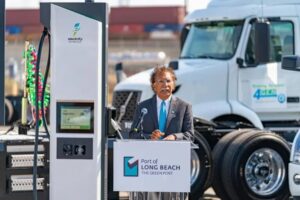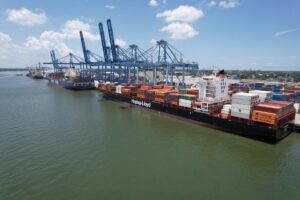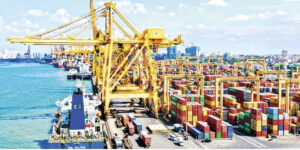The Port Authority of Valencia (PAV) has outlined the success of the H2Ports programme, which has three hydrogen projects ongoing, to members of the Clean Hydrogen Alliance.
PAV plans to transform its docks into a ‘zero emissions’ zone by 2030.
Valenciaport attended the Clean Hydrogen Alliance CEO conference in Brussels, Belgium, where it highlighted the hydrogen projects that are now ongoing and will pave the way for the rest of Europe’s ports to emulate similar efforts.
Joan Calabuig, President of the Port Authority of Valencia, attended this meeting accompanied by Josep Sanz, Director of Energy Transition and Sustainability of the Valenciaport Foundation.
The Clean Hydrogen Alliance conference aims to identify a portfolio of viable projects to be given priority in the future implementation of hydrogen.
In this regard, one of the pillars on which Valenciaport’s environmental policy is built is the use of green hydrogen, which the European Union (EU) has identified as a preferable energy in the construction of important projects to expedite industrial decarbonisation.
At the ceremony, Valenciaport discussed the success of two of the three projects that comprise the H2Ports initiative, as well as the operation of the third (a hydrogen-powered reach stacker truck that will begin operation this July).
READ: Valenciaport announces tender for East Dock intermodal redevelopment
In its first project, Valenciaport tested the use of hydrogen in real-world operations in a tractor unit outfitted with a set of fuel cells used in Ro-Ro terminal loading/unloading operations. Moreover, its second project saw the installation of a transportable hydrogen station.
Josep Sanz stated: “In the development of the third project, two aspects of hydrogen technologies have become clear: that their potential to contribute to a zero emission port is enormous.
“The challenges also became clear, in which the need for innovation, public financial support and collaboration between different types of actors are prerequisites for the successful deployment of this type of solution.
“At this meeting, the plan to develop two hydrogen valleys – one in Valencia for mobility applications and the other in Sagunto for industrial consumption – was also discussed.
“They are an example of how the promotion of synergies can make projects with this green fuel affordable,” concluded Sanz.
READ: Valenciaport, Burgos explore direct rail connection
For decades, all the ports managed by the Port Authority of València have been working to reduce their environmental impact.
This has led naturally to the strategic and ambitious decision to become zero net emissions by 2030.
The action plan to achieve this ambitious goal has been drawn up jointly by PAV, the Valenciaport Foundation and the companies that make up the maritime-logistics-port cluster of Valencia in collaboration with numerous manufacturers and knowledge centres and includes major investments in projects to be developed over the next decade.









